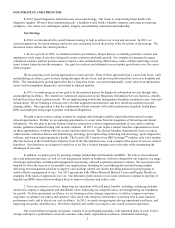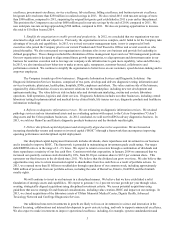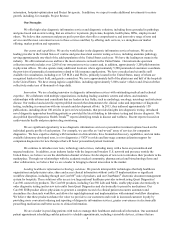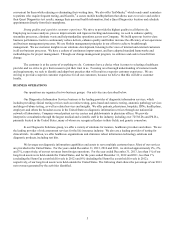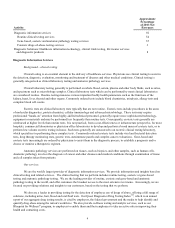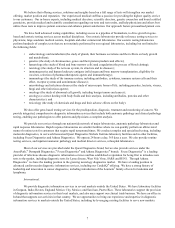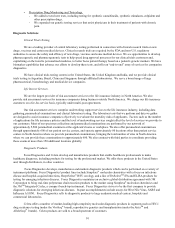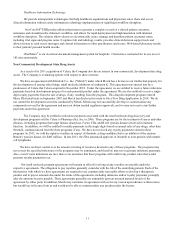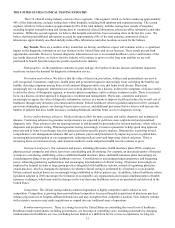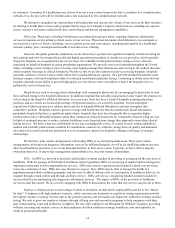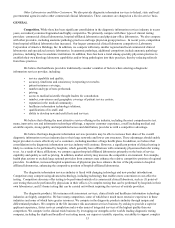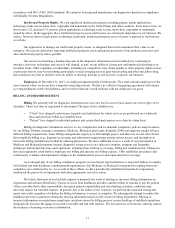Quest Diagnostics 2013 Annual Report Download - page 16
Download and view the complete annual report
Please find page 16 of the 2013 Quest Diagnostics annual report below. You can navigate through the pages in the report by either clicking on the pages listed below, or by using the keyword search tool below to find specific information within the annual report.12
THE UNITED STATES CLINICAL TESTING INDUSTRY
The U.S. clinical testing industry consists of two segments. One segment, which we believe makes up approximately
40% of the total industry, includes testing done within hospitals, including both inpatient and outpatient testing. The second
segment, which we believe makes up approximately 60% of the total industry, includes testing done outside of hospitals,
including hospital outreach testing and testing done in commercial clinical laboratories, physician-office laboratories and other
locations. Within the second segment, we believe that hospital outreach has been increasing share in the last few years. We
believe that hospital-affiliated laboratories account for approximately 60% of the total industry, commercial clinical
laboratories approximately one-third and physician-office laboratories and other locations account for the balance.
Key Trends. There are a number of key trends that are having, and that we expect will continue to have, a significant
impact on the diagnostic information services business in the United States and on our business. These trends present both
opportunities and risks. However, because diagnostic information service is an essential healthcare service and because of the
key trends discussed below, we believe that the industry will continue to grow over the long term and that we are well
positioned to benefit from the long-term growth expected in the industry.
Demographics. As the population continues to grow and age, the burden of chronic diseases and unmet diagnostic
needs may increase the demand for diagnostic information service.
Prevention and wellness. We believe that the value of detection, prevention, wellness and personalized care now is
well recognized. Consumers, employers, health plans and government agencies increasingly focus on helping the healthy stay
healthy, detecting symptoms among those at risk and providing preventive care that helps avoid disease. Physicians
increasingly rely on diagnostic information services to help identify risk for a disease, to detect the symptoms of disease earlier,
to aid in the choice of therapeutic regimen, to monitor patient compliance and to evaluate treatment results. There is increased
focus on a disease-oriented approach to diagnostics, treatment and management. Physicians, consumers and payers
increasingly recognize the value of diagnostic information services as a means to improve health and reduce the overall cost of
healthcare through early detection, prevention and treatment. Federal healthcare reform legislation adopted in 2010 contained
provisions eliminating patient cost-sharing for preventive services, and additional provisions that we believe will increase the
number of patients that have health insurance, including Medicaid, and thus better access to diagnostic testing.
Science and technology advances. Medical advances allow for more accurate and earlier diagnosis and treatment of
diseases. Continuing advances in genomics and proteomics are expected to yield new, more sophisticated and specialized
diagnostic tests. These advances also are spurring interest in and demand for personalized or tailored medicine, which relies on
diagnostic and prognostic testing. Pharmacogenomic testing increasingly is used as a parameter to help speed drug approval
processes and to better focus therapy based on patient and tumor-specific genetic markers. Demand also is growing toward
comprehensive care management solutions that serve patients, payers and practitioners by improving access to patient data,
increasing patient participation in care management, reducing medical errors and improving clinical outcomes. There is
increasing focus on interconnectivity, and electronic medical records and patient health records continue to grow.
Customers and payers. Our customers and payers, including physicians, health insurance plans, IDNs, employers,
pharmaceutical companies and others, have been consolidating and diversifying. For example, an increased number of hospital
systems are considering establishing or have established health insurance plans, and health insurance plans increasingly are
considering providing or are providing healthcare services. Consolidation is increasing pricing transparency and bargaining
power, enhancing purchasing sophistication and encouraging internalization of clinical testing. Physicians increasingly are
employed by hospital systems or large group practices integrated with healthcare systems, instead of organizing physician-
owned practices, which is changing the dynamics for whether clinical testing is performed by a hospital or a non-hospital.
Patient-centered medical homes are increasingly being established to deliver patient care. In addition, federal healthcare reform
legislation adopted in 2010 encourages the formation of accountable care organizations and requires implementation of health
insurance exchanges, which may result in changes in the way that some healthcare services are purchased and delivered in the
United States.
Competition. The clinical testing industry remains fragmented, is highly competitive and is subject to new
competition. Competition is growing from non-traditional competitors. Increased hospital acquisitions of physician practices
enhance physician ties to hospital-affiliated laboratories and may strengthen their competitive position. New industry entrants
with extensive resources may make acquisitions or expand into our traditional areas of operations.
Reimbursement pressure. There is a strong focus in the United States on controlling the overall cost of healthcare.
Healthcare market participants, including governments, are focusing on controlling costs, including potentially by changing
reimbursement for healthcare services (including but not limited to a shift from fee for service to capitation), revising test


